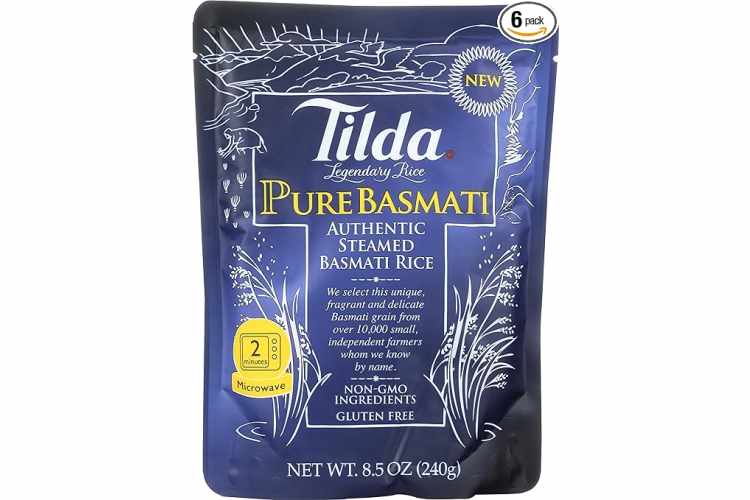Cooking Basmati Rice On Stove
How To Cook Perfect Basmati Rice
We independently select these products—if you buy from one of our links, we may earn a commission.

Perfectly cooked rice grains are like brothers, close, yet separate, and definitely not stuck together. – Indian proverb
A simple pot of basmati rice can defeat even the most experienced cooks, especially when it comes to getting it right, night after night. The perfect rice is soft and fluffy, with each grain perfectly separate. Is this possible at home? Definitely. Just follow these easy, foolproof steps.
Great rice makes every meal better. Watch the video —->
What Is Basmati Rice?
Basmati is one of the best known varieties of rice out there. The word "basmati" comes from the Sanskrit word "vasmati" which means "fragrant" or "aromatic." Long-grained, extremely aromatic, with a light nutty flavor, basmati is grown in the north of India and Pakistan, mainly using traditional growing methods.
The best way to cook the perfect pot of rice can be a pretty contentious topic. Almost 90% of my culinary arguments with my mother are about the best ways to cook rice. We both have strong opinions about everything from whether the rice needs to be soaked first and the quality of rice to the amount of water needed and whether it should be boiling or not.
But the proof of my method is on my table every night — this classic ratio-based, boiling water, absorption method works every time.
5 Tips for Perfect Basmati Rice
- Use the best quality Indian or Pakistani basmati rice you can find and afford. I personally use Tilda, but there are several other good quality brands available.
- Rinse the rice for a few minutes. The water does not need to run perfectly clear, like when rinsing Japanese rice, but rinsing helps get rid of starch that can make your rice sticky.
- Add salt to the rice in the pot, before pouring in the water. This helps the salt absorb into the rice grains. Do not add salt after the rice is cooked, as your rice can taste overly salty.
- I like to pour boiling water over top of the rice in the pot, which helps me keep track of the exact quantity of water I need, and there is no loss of water due to evaporation in my pot.
- Use a tight fitting lid, or ideally, use aluminum foil, crimped tightly over the top of the pot to make a good seal, so that steam doesn't escape. The tightly covered pot lets the rice steam perfectly, and the method consistently yields long, separate, perfectly steamed fluffy grains of rice.

How do you cook your rice and are there any tips you swear by?
What to Serve with Basmati Rice
In the south of India, where I am from, rice is our staple food. All other dishes accompany the rice. Here are a few accompaniments, that go really well with basmati rice:
- alcohol-free
- egg-free
- kidney-friendly
- peanut-free
- low-potassium
- pork-free
- pescatarian
- gluten-free
- tree-nut-free
- red-meat-free
- low-fat
- dairy-free
- fish-free
- vegetarian
- shellfish-free
- vegan
- sugar-conscious
- no-oil-added
- soy-free
- wheat-free
Per serving, based on
6
servings. (% daily value)
- Calories 238
- Fat 0.4 g (0.7%)
- Saturated 0.1 g (0.6%)
- Carbs 52.1 g (17.4%)
- Fiber 0.8 g (3.4%)
- Sugars 0.1 g
- Protein 4.6 g (9.3%)
- Sodium 442.2 mg (18.4%)
Ingredients
- 2 cups
basmati rice (500 ml)
- 3 cups
boiling water (750 ml)
-
Salt to taste
Instructions
-
Rinse the rice: Using a strainer, rinse the rice under cold, running water.
-
Soak the rice (optional): Place the rice in a large bowlful of cold water, and let it soak for 30 minutes to an hour. You can skip this step, but it helps make softer rice.
-
Transfer rice to a heavy based sauce pot with lid: If you've been soaking the rice, drain it well. Transfer it to the sauce pot with a pinch of salt.
-
Pour boiling water over the rice: Boil water in a kettle or pot, measure out 3 cups of boiling water and pour over the rice.
-
Bring to a simmer, then cover with foil and the lid: Set the pot over medium-high heat. When the water starts boiling and steaming again, cover the pot tightly with aluminum foil, crimping the edges around the rim of the pot (so that no steam escapes), and then place the lid on top.
-
Reduce heat and cook the rice: Turn down the heat to just above it's lowest setting and let the rice cook for 15 minutes undisturbed.
-
Remove from heat and steam for 5 minutes: After 15 minutes, remove the pot from heat. With the lid still on (no peeking!), let the rice steam another 5 minutes.
-
Fluff the rice and serve: Uncover the rice, fluff it up with a fork and serve.
Recipe Notes
My mother recommends adding a few drops of plain vinegar to the pot with the rice to help keep the grains separate.
The quantity of salt is to taste. I use about 1/8 teaspoon per cup of rice.
Want more smart tutorials for getting things done around the home?
See more How To posts
We're looking for great examples of your own household intelligence too!
Submit your own tutorials or ideas here!
Michelle Peters-Jones
Contributor
Michelle is a food writer, recipe developer, spice hoarder and social media addict. She is based in Edmonton, Canada and can be found at The Tiffin Box.
Cooking Basmati Rice On Stove
Source: https://www.thekitchn.com/how-to-cook-perfect-basmati-rice-cooking-lessons-from-the-kitchn-211157
Posted by: nguyenbahe1939.blogspot.com

0 Response to "Cooking Basmati Rice On Stove"
Post a Comment